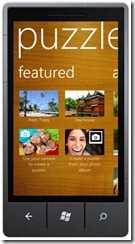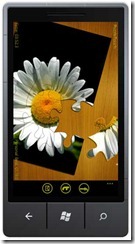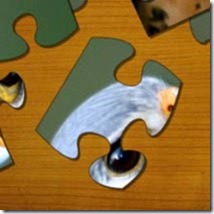There are a lot of reasons for developers to be excited about Windows Phone 7. First and foremost, .NET developers can easily build great apps using the language and tools they already know. If you’re like me, learning a new technology is always fun, but producing great results with minimal effort is better. ![]()
But there’s another thing that developers and stakeholders alike should be excited about that goes beyond the benefit of the minimal learning curve: leveraging the Silverlight eco-system.
Here’s a story, straight from the trenches, of the fantasic combination of code-reuse and redesign to maximize the benefits of the Silverlight ecosystem.
Quick history
In the summer of 2009 I created the award winning site: PuzzleTouch.com. The idea for PuzzleTouch was to take an existing and familiar concept (online jigsaw puzzles) and use Silverlight’s powerful runtime and graphics engine to create the world’s best online jigsaw puzzle app. Today, PuzzleTouch is a culmination of over a year of effort, refinement, and performance improvements.
Along came Windows Phone 7
*Click images to play videos
The decision to port PuzzleTouch to Windows Phone 7 was a no-brainer. First, as a Silverlight developer I already knew 95% of what I needed to know to build a WP7 app. But more importantly, I already had an established code base to start with.
As Tony Taglialucci from Carlitos Way said, “The contract’s already down on you, pal. The guys, the guns,the lime pit’s already dug. And from in here, just one button I push.”
A little over a month ago, I sat down to see if I could get the main PuzzleTouch game play screen to run on WP7. Not to my surprise but much to my excitement, a couple hours later I was dragging puzzle pieces across the WP7 emulator and snapping them together! Here’s the significance: I’ve been dying to build a version of PuzzleTouch that ran on a phone since day 2. I’ve had many users ask if an iPhone version was in the works and for the past year I’ve been toying with the possibility of making the investment. The primary drawback was purely a matter of time… there was learning Objective C (or risking developing with MonoTouch), learning the new tools, and messing with my web services. And then there was still the question, would it even work? What if there was some insurmountable technical hurdle like no support for PolyBezier clipping or unusably poor performance. The learning process would be fun but let’s face it: my free time is precious.
With WP7, I had a working prototype in 2 hours; hot damn! Realizing the hard part was already done, I spent the rest of my effort building a “real” Windows Phone 7 app and not just a Silverlight web app port. Here were some of the challenges and considerations I faced:
Technical Considerations
Have you ever heard the phrase: “It takes 80% of the time to complete the last 20% of the project”? While my initial port to WP7 was an enormous time-saver, there was a little more to it than adding a few new phone related features and dropping a few web specific features. I won’t get into the gory details on everything that needed changing but here’s a list of the major areas that needed attention from a technical perspective.
- Pixel shaders: Silverlight on Windows Phone 7 currently doesn’t not support pixel shaders. A big reason PuzzleTouch for the web looks so realistic has a lot to do with shadows and bevels. Fortunately, I was able to mimic dropshadows by adding a second semi-transparent puzzle piece behind the top one to get me one giant step closer to great looking puzzle pieces.
*Screen shot from actual Windows Phone 7 app.
- Navigation: Had I used the Silverlight Navigation Framework on my website, this may have gone faster. With WP7 you really need to think in terms of pages and be aware of passing around application state. Implementing support for navigation requied modest effort but overal wasn’t not too significant in the big picture.
- Tombstoning: Speaking of application state, it is important to understand that your app can be interrupted at any time by the user receiving and viewing a text message, hitting the search button, …etc. The app needs to be able to save its state when the user navigates away and restore it when they come back. This is not hard to do and there is a great API to help, but it is one you can’t overlook.
- Performance: The PuzzleTouch web version was already finely tuned to support up to 1000 piece puzzles. However, WP7 devices are even less powerful than a netbook and it was necessary for me to revisit performance from top to bottom. In the end hardware acceleration done right saved the day.
- AppBar: Another consideration was effectively using the WP7 AppBar.
The AppBar is the perfect venue for your “extra” options and help save space. Speaking of which…
- Real-estate: Last but certainly not least was the consideration of a much smaller screen. I had to move features to subsequent screens and really think hard about how to maximize the use of the screen to play something that normally requires a considerable amount of space. After all, when was the last time you played a jigsaw puzzle on anything but your dining room table?
Design Considerations
BUT… the technical changes were only part of the story. I cannot stress enough that building a great WP7 app is much more than building a high performance Silverlight web app for a small screen. I wanted PuzzleTouch to look and feel like it was made for the phone… and not just any phone, a Windows Phone. With the help of the new panorama control I completely overhauled the part of the app leading up to the puzzle game play screen. The panorama control was a perfect fit for PuzzleTouch and the funny part is, when it was all said and done, I felt like I had ended up with something possibly even more intuitive and streamlined than in the web version. I was expecting my design choices to be full of compromises but instead it was full of gains. Personally, I think this speaks well to the Metro design paradigm in general. In fact, it makes me wonder if we will start seeing more and more webpages using the metro design in due time. I for one am considering passing on some shifts in design onto the web version. Which leads nicely to my next point…
Vice versa and versa vice
Just like how Silverlight vNext is expected to benefit from the work done on Silverlight for the Windows Phone (e.g. composition thread!), web and desktop apps are likely to benefit from some of the dev and design improvements receiving spotlight from the phone today. I would speculate to say that the average Silverlight developer is more aware of hardware acceleration, frame-rate, multi-theading, and assembly load time performance now than they were before WP7. That is awesome! Silverlight is such a high performance runtime that it is easy to be lazy, but if as developers we learn more from the phone runtime and even make some minor changes to our coding styles, it will make for even better web and desktop apps.
Another great thing in the case of PuzzleTouch was that I was not only able to share code and Xaml, but was even able to share entire assemblies. Therefore, many improvements that I made for the WP7 version have already found their way back to the web version. During the entire WP7 development process I was careful to reuse as much as possible and refactor for extensibility over the copy and alter approach. Although most of the improvements are under the hood, they are still important ones. A few that come to mind are:
- Performance: Much of the performance tuning I did for the WP7 version was applicable to my website. Refining my bitmap caching by using features like RenderAtScale now make PuzzleTouch.com run even smoother.
- Greater use of MVVM: One of the less mentioned benefits of MVVM is the ability to share view models with multiple views. In a single Silverlight web or desktop app it is not too common to have the need for two unique views for the same task, but when sharing code with your WP7 app, this becomes a clear win for using MVVM.
- Styling: In cases where I had built a custom control that could be reused, I still usually needed to style it differently for WP7. Partly to adhere to themes and partly to accommodate a smaller screen size. In these cases, I was able to simply template the control or expose new styling properties. Because of this, I now have more flexible and reusable controls in my PuzzleTouch namespace.
The almighty ecosystem
Possibly the best part about being able to reuse code for the phone and the web is that they can become part of each other’s feature set. With PuzzleTouch, a user can use their phone’s camera to take a picture, turn it into a puzzle, and email it to their friends… who can click on that link and open that puzzle on the website. You might not immediatly see this as a feature of the phone app, but it is to the user. Depending on the app, being able to build an experience for the phone and the web can be invaluable combination. With Silverlight you have this potential and it’s not that hard. I urge those of you who are developing apps for the phone to not overlook this powerful potential.
To conclude, much of what you develop today for the web and desktop can be reused on Windows Phone 7 and vice versa. But don’t be afraid to redesign the UX! Make your web apps shine on the web and your phone apps shine on the phone. The good news is that by using best practices and taking advantage of all the great things in the Silverlight tool chest (Xaml, MVVM, binding, assembly sharing, MEF, …etc.), redesigning the UX while maintaining a common code base is just about as easy as it could be. Once Silverlight for WP7 and Silverlight for the Mac and PC sync up their versions (Silverlight 5!?), it will be even easier.
In the end, I was able to launch a v1.0 WP7 app in under two months in my ‘spare time’ that is arguably on par with to a v3.0 iPhone app. Plus, the website and the phone versions now compliment each other by extending each other’s feature set and I can enjoy the holidays without slaving away at my computer. It is a win for me, win for my users, and win for the platform.
Links
Video of puzzle home page and creating a puzzle from your phone’s picture album
Video of puzzle game play screen (both regular and advanced puzzles)
PuzzleTouch Jigsaw Puzzles in the Windows Phone 7 Marketplace (zune://navigate/?appID=5309e1b0-acf3-df11-9264-00237de2db9e)
Online Jigsaw Puzzles By PuzzleTouch.com


